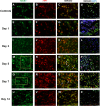Cellular source and proinflammatory roles of high-mobility group box 1 in surgically injured rat vocal folds
- PMID: 27774594
- PMCID: PMC5403630
- DOI: 10.1002/lary.26333
Cellular source and proinflammatory roles of high-mobility group box 1 in surgically injured rat vocal folds
Abstract
Objectives/hypothesis: High-mobility group box 1 (HMGB1) is a chromatin-binding protein located in the cell nucleus. Following injury, immunocompetent cells secrete HMGB1 to the extracellular milieu under the stimulation of proinflammatory cytokines. Extracellular HMGB1 acts a danger signal that instigates the innate immunity and tissue repair. We previously reported HMGB1 in the vocal fold extracellular compartment between day 3 and day 7 following surgical injury. In this study, we further investigated the cell source of HMGB1 and the relationship of proinflammatory cytokine expression and HMGB1 translocation in wounded vocal folds.
Study design: Prospective animal study.
Methods: Bilateral vocal fold injury was performed on 122 Sprague-Dawley rats. An additional 18 rats served as uninjured controls. Animals were sacrificed at multiple time points up to 4 weeks after surgery. Immunohistochemical costaining was performed to identify the cell source of HMGB1. Cell markers ED1, fibroblast-specific protein 1 (FSP1), and alpha smooth muscle actin (α-SMA) were used to identify macrophages, fibroblasts, and myofibroblasts, respectively. Enzyme-linked immunosorbent assays were performed to measure cytokine levels of interleukin-1beta (IL-1β) and tumor necrosis factor-alpha (TNF-α) in vocal fold tissue.
Results: Costaining of HMGB1 was strong with ED1 and FSP1 but was minimal with α-SMA in injured vocal folds. Compared to uninjured controls, IL-1β and TNF-α expression increased significantly the first 2 days after injury.
Conclusions: Macrophages and fibroblasts were a major cell source of vocal fold HMGB1. Translocation of HMGB1 may be an active response to the early accumulation of IL-1β and TNF-α in the wounded vocal folds.
Level of evidence: NA Laryngoscope, 127:E193-E200, 2017.
Keywords: HMGB1; cytokines; inflammation; vocal folds; wound healing.
© 2016 The Authors. The Laryngoscope published by Wiley Periodicals, Inc. on behalf of American Laryngological, Rhinological and Otological Society Inc, “The Triological Society” and American Laryngological Association (ALA).
Figures





References
-
- Foell D, Wittkowski H, Roth J. Mechanisms of disease: a ‘DAMP’ view of inflammatory arthritis. Nat Clin Pract Rheumatol 2007;3:382–390. - PubMed
-
- Wang H, Yang H, Tracey KJ. Extracellular role of HMGB1 in inflammation and sepsis. J Intern Med 2004;255:320–331. - PubMed
-
- Yang H, Tracey KJ. High mobility group box 1 (HMGB1). Crit Care Med 2005;33:S472–S474. - PubMed
Publication types
MeSH terms
Substances
Grants and funding
LinkOut - more resources
Full Text Sources
Other Literature Sources
Research Materials

